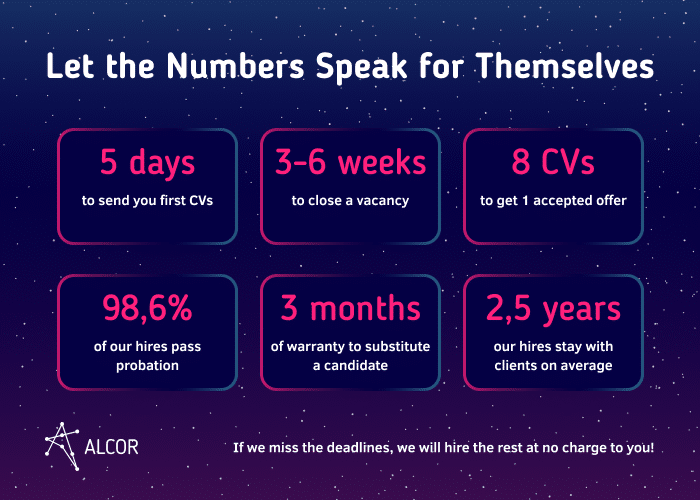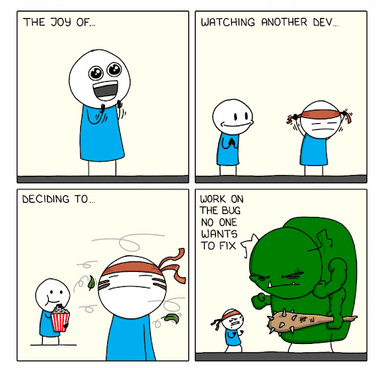Software development facts and figures prove that computer programming careers are in high demand, projecting employment to grow 25% from 2022 to 2032. However, understanding the sphere of programming is no mean feat. Before you discover the best practices of finding and hiring tech talent, you should put yourself in the developer’s shoes.
I’m Maryna Panchuk, Head of IT Recruitment at Alcor. We hire Silicon-Valley-like developers for tech companies that broaden their horizons to Latin America and Eastern Europe. Our 360-degree R&D center solution includes tech recruitment, EoR services, and operational support — everything for swift and 100% compliant expansion.

In this article, I’ll share a few interesting and fun facts about programmers and software development. These insights will help you work in sync with coders and achieve your expansion goals. So, let’s get started and remember, “Programming is like magic; if you do it right, you can create anything from thin air!”
Why is Software Engineering So Popular?
The software development industry has grown fast and furiously! By 2030, its revenue will exceed $1 billion. With the rising need for innovative software across multiple fields, the limited lifespan of code, the accelerated evolution of technology, and increased project complexity, the need for skilled IT experts is skyrocketing.
One of the key facts about programmers is that there is never enough talent. Even though the number of software developers is set to hit 28.7 million in 2024, the shortage of qualified tech experts is still a burning issue. That’s why many tech companies are casting their nets wide, expanding to booming markets like Latin America and Eastern Europe to stay ahead of the curve. Did you know these regions account for 3 million software developers who excel in data science, mobile development, computer programming, and cloud computing? Find more facts about development in our articles about IT outsourcing in Latin America and outsourcing to Eastern Europe. Meanwhile, we’re diving into more facts about computer programmers!
9 Facts About Software Development Specialists
-
This job pays big bucks
The national average salary for a Software Developer in the US soared to a staggering $132,270 in 2023. Unsurprisingly, this profession ranks in the top 3 in the market! What’s more, a developer’s salary can climb even higher, reaching up to $160,000, especially if they master trendy technologies like Blockchain or programming languages like Golang. This high earning potential makes software development an attractive career choice for many.

However, employers might find this a bit of a pickle, especially regarding salary rates and hunting talent. That’s why offshoring or nearshoring could be a good way out. With a great deal of experience in EoR services and tech recruitment in Poland and other EE and LATAM countries, I’d say it not only slashes your labor costs but also opens the door to a pool of rare tech talent. It’s a win-win for your company!
-
Coders are younger than everyone else
Did you know that around 60% of coders are under 35, with the median age at 43? That’s what Kinsta found and shared in its Software Engineering Statistics 2023. So, if you are looking for software developers, you’ll definitely scale your team with young folks brimming with fresh ideas for your projects and infinite passion for coding.

-
Who said university degree? Not obligatory!
60% of programmers learned to code online, another cool fact about being a software developer from Kinsta’s report. That’s right, you don’t need a fancy engineering degree to land a job in IT. In addition, computer science trends emerge too fast for even top universities to update their curriculums. So, tech companies prefer hiring talents with practical skills. In the end, being self-taught is an asset whether or not you’re pursuing a relevant degree.
Expanding to LATAM? Discover the tech qualification of software developers in Colombia!
-
JavaScript — the king of the coding kingdom
Now, getting to more tech-related facts about software engineering, so buckle up! Let’s start with JavaScript (which is not the same as Java). It was and continues to be the most loved programming language among developers, according to Statista. Created by Brendan Eich in just 10 days, JavaScript was initially meant only for building web pages. But with the advent of Node.JS, it can now be used on the server side to create scalable network applications. Amazingly, JavaScript is used by over 95% of all websites.

-
C++, who doesn’t love a good brain teaser?
C++ is a popular programming language for developing operating systems, managing databases, creating games, applications, web browsers, and much more. However, it is also one of the hardest languages to learn compared with Python and Java. C++ has advanced syntax, and its code is less readable because it doesn’t resemble English as much as Python. As developers like to say: “C++ is an easy language to learn. I’ve been learning it for over 30 years.” It is hard to come to grips with the intricacies of this language, but it is absolutely worth it.
Discover the Build Operate Transfer in outsourcing as a way to build a development team abroad!
-
Programmers are real job-hoppers
Another fact about software development is that IT talents are known to change jobs every 2-3 years. From coders’ view, staying in one workplace for long is unnecessary because that implies no significant salary bumps and using the same old skills. Meanwhile, trying a variety of projects and company types can help their tech experience and salary reach new levels. For employers, this means it’s time to up your game. Toss in more challenging tasks and regular KPI reviews for salary raises. Keep those coders on their toes, and they’ll stick around longer!
-
Remote work is a lifestyle
One of the coolest perks of being a developer is the freedom it offers. More than 83% of programmers work either entirely remotely (41.41%) or in a hybrid model (42.18%). The State of Remote Engineering Report by Terminal states that working remotely is still a booming trend, with 54% of coders preferring this option and 13% saying the flexibility of remote work is their main reason for switching jobs. Tech executives take note: consider going fully remote. You’ll give your top talent the freedom they crave and enjoy the perks of lower labor costs. After all, happy coders mean better code!
Discover the pros and cons of cooperating with IT outsourcing providers in Romania!
-
Moving up the career ladder like a flash
A developer’s career is generally quite straightforward. While there are different classifications, on average, computer engineers work for 2-3 years as juniors, then qualify for a middle role, and after 5-6 years of experience, they are ready to hold a senior position. When reaching a lead role, though, programmers can choose between engineering and managerial paths. While the former still allows tech talents to grow in the tech realm, the latter is more oriented toward leadership and achieving business goals.

-
AI is a friend, not a competitor
One of the alarming facts about software engineers relates to the hype around AI replacing programmers. Contrary to popular belief, it isn’t going to happen anytime soon. Thomas Dohmke, GitHub CEO, believes that not only will AI not take over developers’ jobs, but it will actually help them learn in augmented environments, such as Copilot, and assist in coding faster with fewer bugs. Thus, software engineers can shake off the burden of menial work and focus on more complex problems instead.
6 Fun Facts About Software Engineering
-
First program dates back to 19th century
Yes, you heard it right! It was written by Ada Lovelace in 1842. Passionate about math, she used her unparalleled and visionary thinking to come up with the algorithm for Babbage’s calculating machine, “The Difference Engine.” While translating a paper by Italian engineer Luigi Manabrea, Ada added many pages of her own notes, reimagining the idea of mere calculation in that machine. Even though Babble’s computer was never built, Ada’s contribution to computer programming was monumental.
-
“Computer” was women’s only occupation
Considering the modern gender gap in tech, it may be hard to believe that programming (once called computing) used to be a solely women’s occupation. The first modern computer, ENIAC, was run by a team of six women: Betty Holberton, Marlyn Wescoff, Ruth Lichterman, Kay McNulty, Betty Jean Jennings, and Fran Bilas. Through extensive planning, learning ENIAC’s logical diagrams, and endless configuration of wires, they set the first programming principles and developed a new field of computer programming — debugging.
-
The first computer bug was a moth — or was it?
The famous fact about engineering states that the “first actual case of a bug being found” in the computer dates back to 1947. A team of engineers working on Harvard University’s Mark II computer found a moth stuck in the machine’s components. Since then, “debug” and “bug” have become part of computer slang and have been widely adopted. Interestingly, this was not the first time computer defects were called “bugs.” In 1878, Thomas Edison used this term to describe machine defects or faults. But the story involving Grace Murray Hopper, a pioneering computer scientist, did the trick and embedded the term into tech history.

-
The logic behind the names of coding languages:
- Java was created by James Gosling in 1991. Inspired by the oak tree outside his office, he initially called it “Oak.” However, potential copyright issues forced the company to come up with an alternative name — “Java.” It was a popular slang term for coffee at that time. Since programmers drink coffee by the gallon, “Java’” seemed fitting. Plus, it was easy to spell and remember.
- Ruby was devised by Japanese software programmer Yukihiro Matsumoto in 1993. Inspired by Perl, he wanted his programming language to have an elegant yet simple name. Together with his colleague Keiju Ishitsuka, they developed Ruby and Coral. The latter was longer by one character, making it a bit of a mouthful to write multiple times. So, they opted for a shorter Ruby. By coincidence, pearl is a birthstone of June, while ruby of July, making it a perfect fit for Perl’s successor.
- Python was not named after a snake; surprise, surprise! Python is an object-oriented programming language created by Guido van Rossum. He was a big fan of the BBC comedy sketch series Monty Python’s Flying Circus.’ So, when looking for a short yet unique and mysterious name for his coding language, he got inspired by the TV show and named his invention Python.

-
The tales behind big tech names:
- So, why Apple? Several theories are swirling around this fruity name. One suggests it’s a nod to Isaac Newton, who discovered gravity after an apple fell on his head. Actually, the first logo even showed this scene but got a makeover to a simpler design. Another theory credits Steve Jobs’ love for the Beatles’ Apple Corps label. And let’s not forget the famous bite out of the logo, rumored to honor Alan Turing’s tragic apple incident. But the truth? According to Jobs, it was because he was on a fruitarian diet and had recently visited an apple farm.
- Google got its name due to a typo — shocking! Initially, the leading tech giant’s name should have been googol, referring to a large number. However, someone made a mistake when registering the domain google.com. Nothing happens by chance, as they say, and in the case of Google, it was a windfall success.
- Meta or Facebook, that’s the question. The mystery behind Facebook changing its name is quite simple. In 2021, Facebook rebranded itself as Meta to show its ambition to go beyond social media and enter a new world of metaverse — a 3D space for working and playing. Meta CEO Mark Zuckerberg expressed his thoughts about the metaverse as the next frontier, just like social networking once was.
4 Untold Truths About Being A Software Engineer
-
Overtime — coder’s beloved companion
Now, discouraging facts about being a software engineer include working overtime. According to Statista, only 10% of developers admitted they had never worked long hours. Highly stressful deadlines are typical for products in the development stage, which involves testing and debugging before the launch. Aside from being mentally exhausting, such situations can lead to burnout.

One of our clients, Sift, aimed to hire 30+ developers in Eastern Europe. However, a Full Stack Developer with unique tech skills required more attention. Alcor recruiters soon realized that the tasks were too many for one engineer to handle. Instead, we suggested hiring a Front End Developer and a Back End Engineer who could maintain productivity without working overtime. Now, in the US, this change would mean significant expenses. But in the EE market, the costs still remained low. Sift agreed to our suggestion, and it turned out to be a winning solution. So, for employers, a healthy work environment and work-life balance should always be top priorities.
-
Sitting wrecks programmers’ health
While interviews and long hours can somehow be managed, the most shocking facts about software developers are related to their health. Bad back and wrists, eye strain, brain fog, and feeling exhausted from focusing on one aspect for too long are the most frequent issues. The essential tip here? Ensure your employees have the right working equipment that matches their needs, and try to broaden the tasks as much as possible.
-
Live and learn
There’s no limit to arising challenges for those who have chosen computer programming! Even though hard skills are common in this way, software engineering facts prove that this requirement is innumerable. For instance, a Full Stack Developer must know at least 4-6 main programming languages and frameworks, including emerging trends and AI improvements. In a nutshell, while software developers never get bored, they should also brace themselves for lifelong learning.

-
Developers are fed up with interview marathons
The State of Remote Engineering 2023 report reveals some juicy details about what bugs programmers most during job interviews. Turn out, 47% mention too many rounds, 44% struggle with delays, and 22% dislike genetic formats. For companies, it is essential to be aware of these programmers’ facts and streamline their hiring process so as not to lose their candidates halfway. The best way to avoid it is via cooperation with a professional tech recruitment and EoR provider who knows all the ins and outs of the hiring process.
Consider Alcor BPO Your Trusted Partner
At Alcor, we do our best to keep tech talent from slipping through your fingers. Unlike other providers, we cover every minor aspect of the expansion journey. It all starts with full-cycle IT recruitment services in Romania and other EE and LATAM countries that cover everything from creating an ideal candidate profile and EVP to sourcing and job interviewing. Then, we offer our Employer of Record services, including compliant onboarding/offboarding of developers, monthly payroll & accounting coverage, remuneration remittance, and employee benefits management. In addition, you can also tap into our operational support for office leasing or hardware procurement. All of that is wrapped in our R&D center solution to bring you peace of mind in the new market.

You’ll enjoy:
- High-quality developers: 98% of hires pass probation with flying colors.
- Up to 40% savings: cheaper than offshore development outsourcing.
- Absence of buy-out fees: the development team is yours from day 1.
- 100% transparency: only direct salaries and a pay-as-you-go approach.
- Zero launch cost & risk: no need for legal entity and setup fees; be protected by our liability shield.
Tech companies such as ThredUP, People.ai, BigCommerce, and Dotmatics are already reaping the benefits of our comprehensive solution. Try it out yourself!
FAQ
1. How popular is software development?
A software engineer is seen as the best job of 2022, and its popularity is expected to grow further. More and more businesses are aiming for automation, and with data science, machine learning and AI gaining more popularity, software developers are at the top of all world trends.
2. What facts should I know about being a software developer?
Software developers are relatively young and well paid, enjoy the opportunity to travel and grow careerwise, and need salary raises and work challenges to stay at one company for more than 3 years. And no, AI won’t replace them.
3. What are the negative aspects of being a developer?
As with any computer-related job, health is in peril. Other disadvantages include a lengthy hiring process, plus the constant need for keeping up with learning trends and most likely a lot of overtime.
